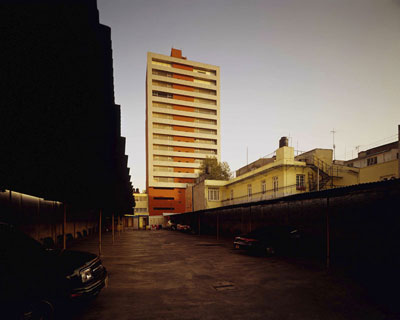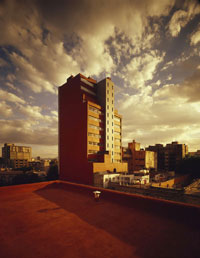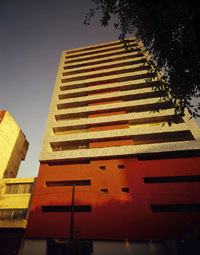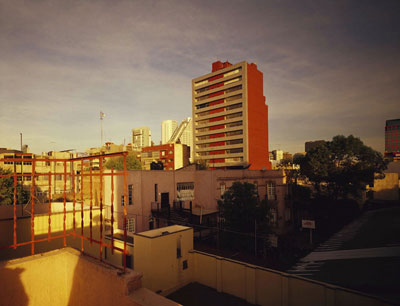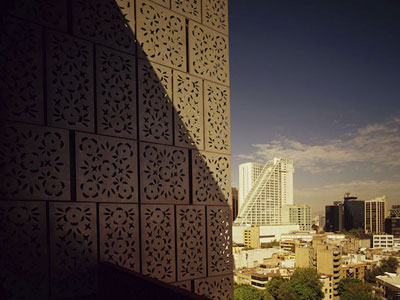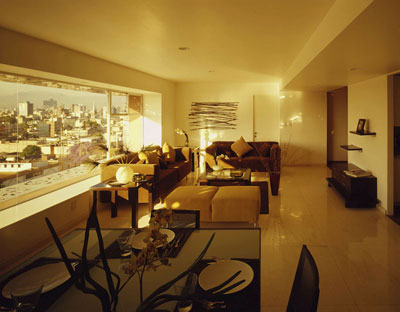 Ver
planos de la obra Ver
planos de la obra
 English
version English
version
El proyecto consistió en
la remodelación de un edificio de oficinas construido
en 1981, para ser convertido en un edificio habitacional
con 23 departamentos. El edificio se encuentra en la
colonia Juárez, en una zona catalogada
como patrimonio histórico. Es por ello que se tuvieron que seguir
varios lineamientos que respetaran dicho entorno histórico.
La estructura original del edificio se dejo prácticamente
intacta. Los primeros cuatro niveles del edificio sirven
de estacionamiento y el resto de los niveles albergan
departamentos de distintos tamaños (de entre 137
y 189 m2), algunos de los cuales cuentan con terrazas
privadas. La estrategia a seguir fue dejar las zonas
de servicio en el corazón de los departamentos,
para así dejar que todos los espacios habitables
tuvieran vistas hacia la ciudad.
Se diseñó una fachada de metal
picado tanto
en la fachada principal como en la fachada posterior
del edificio. Este elemento se inspira en la
tradicional artesanía mexicana de papel picado y
sirve para ocultar la antigua fachada, para generar un
elemento
atractivo que incentive la comercialización de
los departamentos, para "horizontalizar" el
edificio (ya que el edificio tiene una escala mucho mayor
a la
de sus vecinos), para dar un cierto orden y embellecer
de cierta forma al caótico contexto urbano.
Se trabajó cuidadosamente en el dibujo de cada
una de las placas de acero, tomando como referencia el
dibujo original de un papel picado comprado en el mercado
de San Angel. Esta textura metálica se contrapone
con un aplanado en tono rojizo en el resto del
edificio,
que procura mimetizar el mismo con su entorno urbano,
en especial con las azoteas y su tratamiento convencional
de impermeabilizante rojo.
English
version
The project involves
the refurbishment of a former office building built in
1981, to be converted into a residential building with
23 apartments. It is worth saying that this building
was considerably damaged during the 1985 earthquake.
The whole building leaned itself towards the street by
1.20 meters, so the building had a big structural intervention
that straightened it to its former position and reinforced
the foundations heavily so to never have a problem again.
This building is located in the Juarez district, within
a historic protected area. We first developed a full
project that at the end of the process (one year and
a half) was rejected by the local authorities.
They argued
that because of the scale of the building (the only building
with 15 floor plans in the area), we should be more considerate
with the surroundings.
We were asked by our client to redesign the proposal,
so we went to the drawing board again and ended up with
a proposal that considered a visual continuum at street
level with the adjacent buildings, emphasizing the building
in a horizontal way and connecting it visually with its
surroundings by the use of color.
The original structure of the building was left virtually
intact. The first four levels of the building provide
parking area and the rest of the levels house apartments
of different sizes (between 137 and 189 m2), some of
which have private terraces. The strategy was to leave
the service areas in the heart of the apartments (kitchen,
laundry and bathrooms), so as to allow all living areas
to be as big and airy as possible and to have views of
the city.
We designed a pierced steel facade in the main and rear
facades of the building. This element was inspired by
the traditional mexican handcraft of papel picado, where
a piece of paper is chopped leaving holes in form of
flowers, animals, people, etc.
The function of this element is to hide the old facade,
to give as much views as possible to each apartment,
to create an attractive element that would help with
the marketing issues and to create a certain order and
beauty within the chaotic urban context.
We worked carefully in the design of each of the steel
plates, with reference to the original design of a papel
picado bought in the market of San Angel. The texture
provided by the metal facade contrasts with the application
of a reddish stucco in the rest of the building, which
seeks to integrate (with a low budget) the building with
its urban context, especially with their roofs treated
with waterproof red paint, which is one of the most common
urban landscapes found in Mexico City.
Planos
Realice click en los links para ver los planos.
[1] Plantas
1
[2] Plantas
2
[3] Plantas
3
[4] Cortes
[5] Vistas
Imágenes
Realice click sobre las imágenes para ampliarlas.
|









